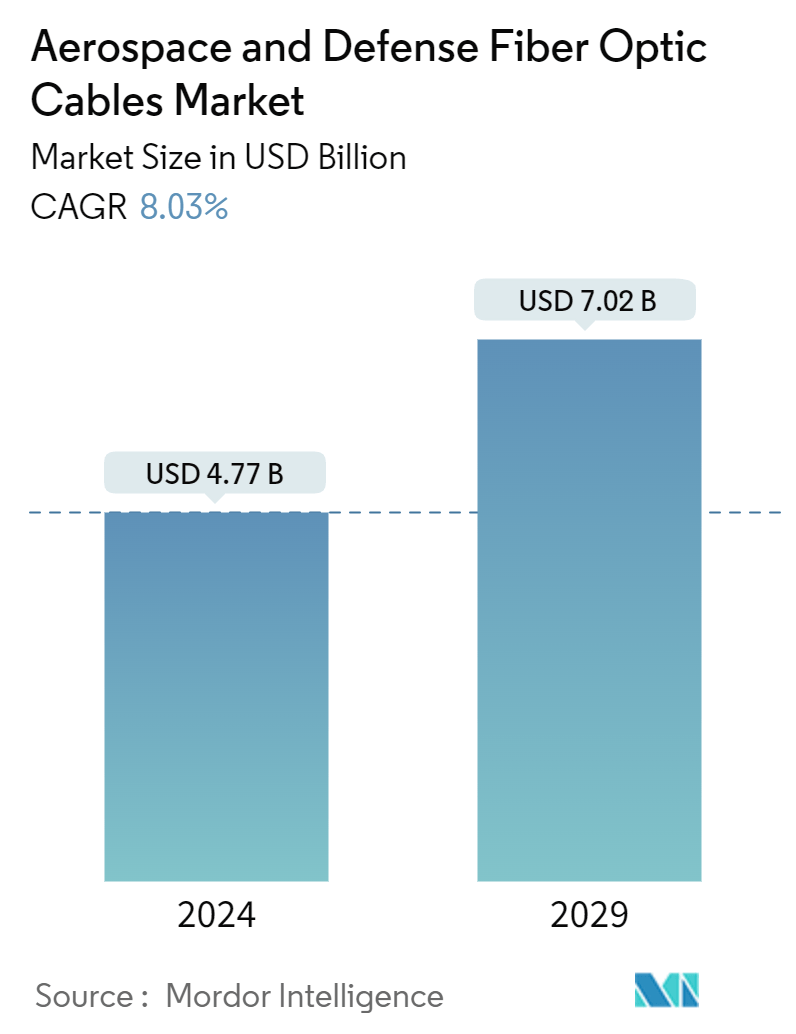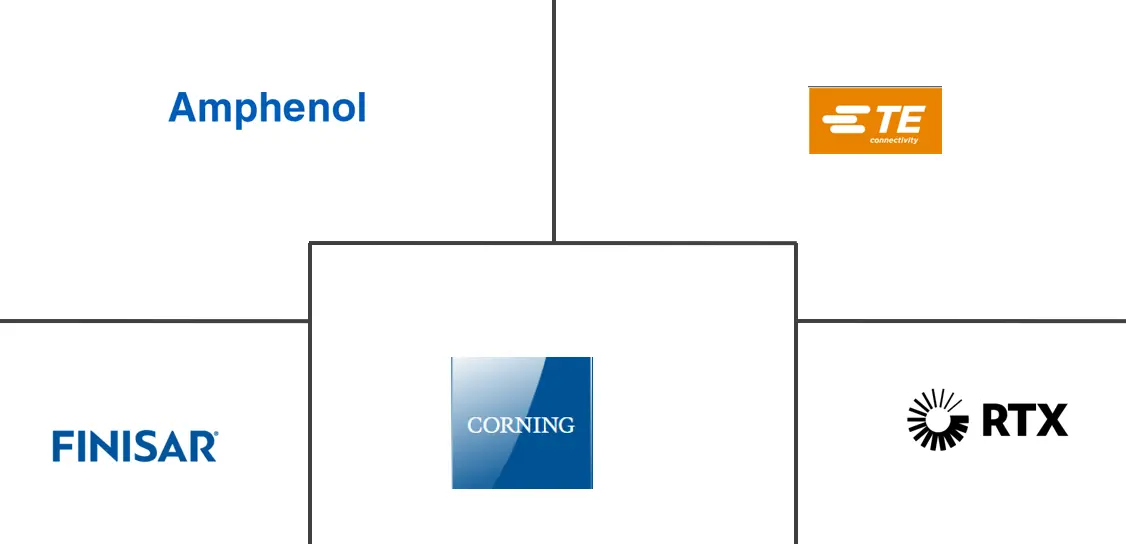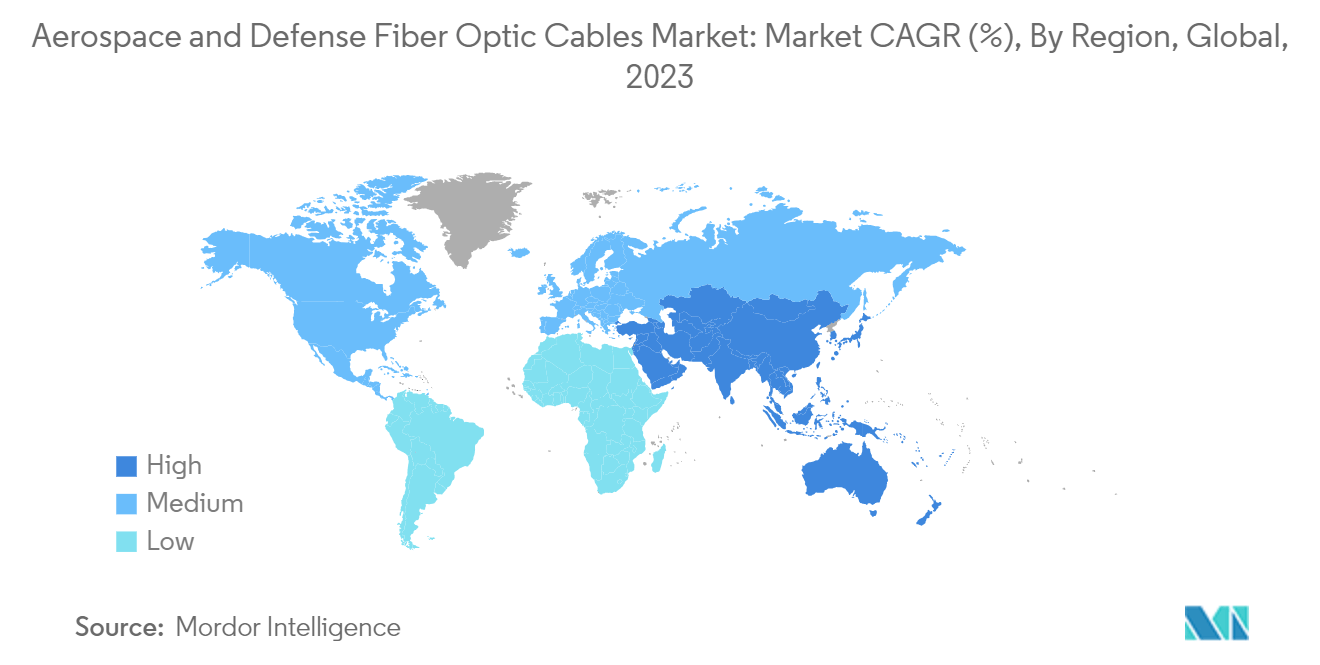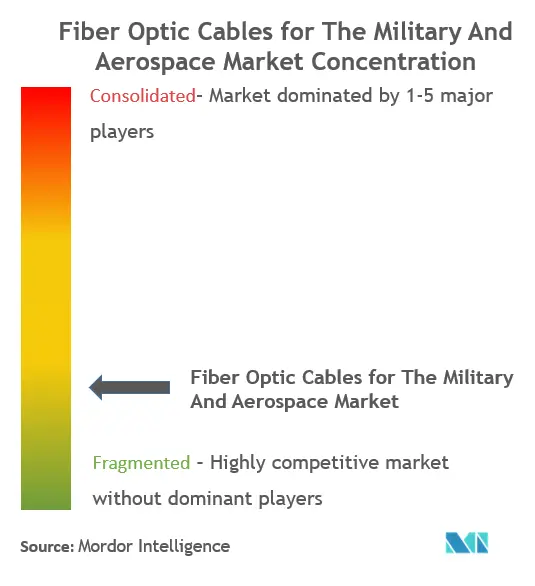Aerospace And Defense Fiber Optic Cables Market Size

| Study Period | 2019 - 2029 |
| Market Size (2024) | USD 4.77 Billion |
| Market Size (2029) | USD 7.02 Billion |
| CAGR (2024 - 2029) | 8.03 % |
| Fastest Growing Market | North America |
| Largest Market | Asia Pacific |
Major Players
*Disclaimer: Major Players sorted in no particular order |
Aerospace And Defense Fiber Optic Cables Market Analysis
The Aerospace And Defense Fiber Optic Cables Market size is estimated at USD 4.77 billion in 2024, and is expected to reach USD 7.02 billion by 2029, growing at a CAGR of 8.03% during the forecast period (2024-2029).
The market for aerospace and defense fiber optic cables is expected to witness significant growth. This can be attributed to the rising number of aircraft deliveries and an increasing demand for improved throughput and reliability. Authorities are now prioritizing adopting advanced solutions, replacing older cables, and further accelerating market expansion. With their innovative offerings, noteworthy players like Carlisle Interconnect Technologies are poised to drive this growth.
This market’s challenges loom in installing and maintaining fiber optic cables. These challenges include inflexible control models, risks to optical network systems, high costs, and susceptibility to damage, which hamper the growth of the market. Balancing the need for cost-effective fiber optics with maintaining high quality presents both an opportunity and a challenge for the market.
Aerospace And Defense Fiber Optic Cables Market Trends
The Multi-mode Segment is Expected to Record the Highest CAGR During the Forecast Period
Multi-mode fiber optic cables, with their larger core diameter, can propagate multiple light modes, enabling the transmission of higher data volumes simultaneously. However, signal quality may suffer over long distances due to the high attenuation rate and data volume. Operating within the visible spectrum, these fibers have light wavelengths ranging from 850 to 1300 nm. Core-to-cladding diameter ratios typically range from 50-125 um to 62.5-125 um in multi-mode fibers.
Multi-mode fiber optics are primarily used in LANs, especially for short-distance data and audio/video applications, and they are witnessing increased adoption in the aviation industry. This adoption transforms avionics and aerospace systems, introducing new system maintenance, testing, and diagnostics challenges. Airlines are shifting from shared overhead screens to individual seatback screens, enhancing personalized services and influencing revenues. As airlines make this transition, traditional copper cabling and its associated electronics are giving way to fiber optic solutions. Multi-mode fiber optics, with data rates surpassing 10 GB/s, are the go-to choice for transmitting data across large wide-body aircraft.
In the military and defense sectors, fiber optic cables are customized for harsh environments, emphasizing application-specific designs and rigorous testing. These cables find applications across various military domains, from ground and air to sea and even space, where performance and reliability under extreme conditions are non-negotiable.

Asia-Pacific is Expected to Dominate the Market During the Forecast Period
Throughout the forecast period, Asia Pacific is expected to dominate the market for aerospace and defense fiber optic cables. China and India are channeling significant investments into various programs, from aircraft and C4I systems to mission support and space-based initiatives, solidifying the region's market leadership. Major players such as Amphenol, Carlisle Interconnect Technologies, and Corning Optical Communications, all anchored in the Asia-Pacific region, further fortify the market's prowess.
Asia-Pacific is the swiftest-growing hub for military and aerospace fiber optic cables. This growth is predominantly steered by the robust economies of China and India, their escalating defense investments, heightened interest from global and local players, and a surge in R&D endeavors.
Factors such as regional challenges, such as insurgencies, territorial disputes, and political tensions further boost the demand. When combined with favorable regulatory landscapes, these factors significantly enhance the appeal of the Asia-Pacific market for aerospace and defense fiber optic cables.

Aerospace And Defense Fiber Optic Cables Industry Overview
The market for aerospace and defense fiber optic cables is fragmented. The major players include Amphenol Corporation, RTX Corporation, TE Connectivity Ltd, Corning Incorporated, and Finisar Corporation.
Market players are bolstering their product portfolios and striving for a lasting competitive edge through strategic moves like partnerships and acquisitions. In February 2024, RTX Corporation partnered with the US Air Force. Their goal is to pioneer high-power lasers, setting the stage for future military applications. This collaboration promises to steer advancements in fiber optic technologies, particularly in defense applications.
Aerospace And Defense Fiber Optic Cables Market Leaders
-
Amphenol Corporation
-
RTX Corporation
-
Corning Incorporated
-
Finisar Corporation
-
TE Connectivity Ltd.
*Disclaimer: Major Players sorted in no particular order

Aerospace And Defense Fiber Optic Cables Market News
January 2024: Amphenol Corporation unveiled a new line of high-performance fiber optic connectors tailored for demanding military and aerospace settings, underscoring their commitment to innovation.
November 2023: Prysmian Group wrapped up a significant subsea interconnector venture linking Italy and Greece, underscoring its prowess in managing intricate cable infrastructure projects, which are expected to have potential implications for the military and aerospace sectors.
Aerospace And Defense Fiber Optic Cables Market Report - Table of Contents
1. INTRODUCTION
- 1.1 Study Assumptions and Market Definition
- 1.2 Scope of the Study
2. RESEARCH METHODOLOGY
3. EXECUTIVE SUMMARY
4. MARKET DYNAMICS
- 4.1 Market Overview
- 4.2 Market Drivers
- 4.3 Market Restraints
-
4.4 Porter's Five Forces Analysis
- 4.4.1 Bargaining Power of Buyers/Consumers
- 4.4.2 Bargaining Power of Suppliers
- 4.4.3 Threat of New Entrants
- 4.4.4 Threat of Substitute Products
- 4.4.5 Intensity of Competitive Rivalry
5. MARKET SEGMENTATION
-
5.1 Application
- 5.1.1 Communication Systems
- 5.1.2 Avionics
- 5.1.3 Weapon Systems
- 5.1.4 Surveillance and Reconnaissance
- 5.1.5 Electronic Warfare
-
5.2 Type
- 5.2.1 Single-mode
- 5.2.2 Multi-mode
-
5.3 Geography
- 5.3.1 North America
- 5.3.1.1 US
- 5.3.1.2 Canada
- 5.3.2 Europe
- 5.3.2.1 United Kingdom
- 5.3.2.2 France
- 5.3.2.3 Germany
- 5.3.2.4 Russia
- 5.3.2.5 Rest of Europe
- 5.3.3 Asia-Pacific
- 5.3.3.1 China
- 5.3.3.2 India
- 5.3.3.3 Japan
- 5.3.3.4 South Korea
- 5.3.3.5 Rest of Asia-Pacific
- 5.3.4 Latin America
- 5.3.4.1 Brazil
- 5.3.4.2 Rest of Latin America
- 5.3.5 Middle East and Africa
- 5.3.5.1 Saudi Arabia
- 5.3.5.2 United Arab Emirates
- 5.3.5.3 Rest of Middle East and Africa
6. COMPETITIVE LANDSCAPE
- 6.1 Vendor Market Share
-
6.2 Company Profiles*
- 6.2.1 Amphenol Corporation
- 6.2.2 RTX Corporation
- 6.2.3 TE Connectivity Ltd
- 6.2.4 Corning Incorporated
- 6.2.5 Finisar Corporation
- 6.2.6 Prysmian Group
- 6.2.7 Optical Cable Corporation
- 6.2.8 Radiall
- 6.2.9 Timbercon
- 6.2.10 L. Gore & Associates Inc.
7. MARKET OPPORTUNITIES AND FUTURE TRENDS
** Subject To AvailablityAerospace And Defense Fiber Optic Cables Industry Segmentation
Fiber optic technology transmits data using highly flexible, transparent fibers of extruded glass or plastic. Fiber optic cables incorporate glass threads as thin as human hair, transmitting messages modulated into light waves. Although these cables are made of glass, they are highly durable and malleable.
The market for aerospace and defense fiber optic cables is segmented by application, type, and geography. By application, the market is segmented into communication systems, avionics, weapon systems, surveillance and reconnaissance, and electronic warfare. By type, the market is segmented into single-mode and multi-mode. The report also covers the market sizes and forecasts in major countries across different regions. The market size is provided for each segment in terms of value (USD).
| Application | Communication Systems | |
| Avionics | ||
| Weapon Systems | ||
| Surveillance and Reconnaissance | ||
| Electronic Warfare | ||
| Type | Single-mode | |
| Multi-mode | ||
| Geography | North America | US |
| Canada | ||
| Geography | Europe | United Kingdom |
| France | ||
| Germany | ||
| Russia | ||
| Rest of Europe | ||
| Geography | Asia-Pacific | China |
| India | ||
| Japan | ||
| South Korea | ||
| Rest of Asia-Pacific | ||
| Geography | Latin America | Brazil |
| Rest of Latin America | ||
| Geography | Middle East and Africa | Saudi Arabia |
| United Arab Emirates | ||
| Rest of Middle East and Africa |
Aerospace And Defense Fiber Optic Cables Market Research FAQs
How big is the Aerospace And Defense Fiber Optic Cables Market?
The Aerospace And Defense Fiber Optic Cables Market size is expected to reach USD 4.77 billion in 2024 and grow at a CAGR of 8.03% to reach USD 7.02 billion by 2029.
What is the current Aerospace And Defense Fiber Optic Cables Market size?
In 2024, the Aerospace And Defense Fiber Optic Cables Market size is expected to reach USD 4.77 billion.
Who are the key players in Aerospace And Defense Fiber Optic Cables Market?
Amphenol Corporation, RTX Corporation, Corning Incorporated, Finisar Corporation and TE Connectivity Ltd. are the major companies operating in the Aerospace And Defense Fiber Optic Cables Market.
Which is the fastest growing region in Aerospace And Defense Fiber Optic Cables Market?
North America is estimated to grow at the highest CAGR over the forecast period (2024-2029).
Which region has the biggest share in Aerospace And Defense Fiber Optic Cables Market?
In 2024, the Asia Pacific accounts for the largest market share in Aerospace And Defense Fiber Optic Cables Market.
What years does this Aerospace And Defense Fiber Optic Cables Market cover, and what was the market size in 2023?
In 2023, the Aerospace And Defense Fiber Optic Cables Market size was estimated at USD 4.39 billion. The report covers the Aerospace And Defense Fiber Optic Cables Market historical market size for years: 2019, 2020, 2021, 2022 and 2023. The report also forecasts the Aerospace And Defense Fiber Optic Cables Market size for years: 2024, 2025, 2026, 2027, 2028 and 2029.
Aerospace And Defense Fiber Optic Cables Industry Report
Statistics for the 2024 Aerospace And Defense Fiber Optic Cables market share, size and revenue growth rate, created by Mordor Intelligence™ Industry Reports. Aerospace And Defense Fiber Optic Cables analysis includes a market forecast outlook for 2024 to 2029 and historical overview. Get a sample of this industry analysis as a free report PDF download.



